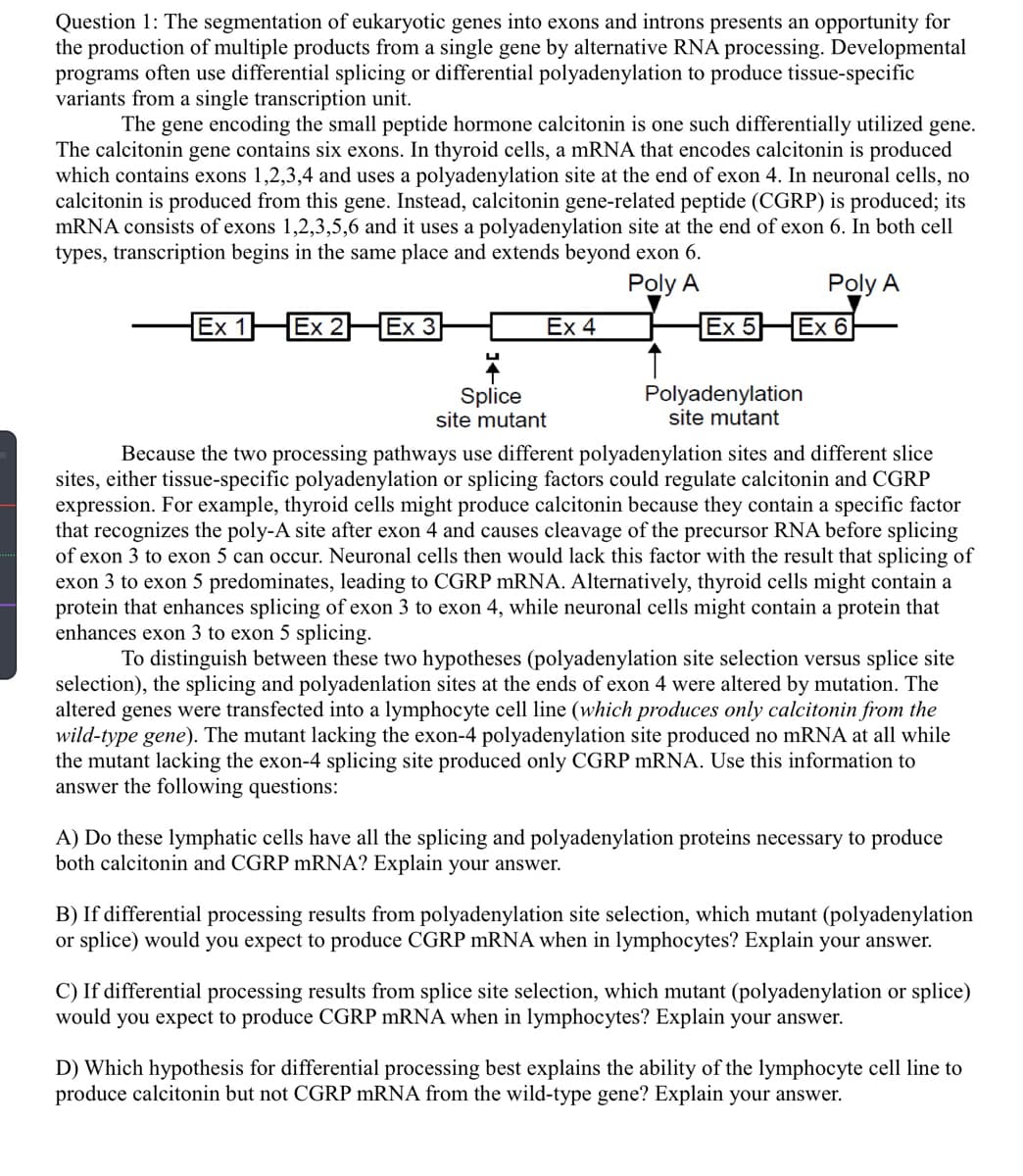Question 1: The segmentation of eukaryotic genes into exons and introns presents an opportunity for the production of multiple products from a single gene by alternative RNA processing. Developmental programs often use differential splicing or differential polyadenylation to produce tissue-specific variants from a single transcription unit. The gene encoding the small peptide hormone calcitonin is one such differentially utilized gene. The calcitonin gene contains six exons. In thyroid cells, a mRNA that encodes calcitonin is produced which contains exons 1,2,3,4 and uses a polyadenylation site at the end of exon 4. In neuronal cells, no calcitonin is produced from this gene. Instead, calcitonin gene-related peptide (CGRP) is produced; its mRNA consists of exons 1,2,3,5,6 and it uses a polyadenylation site at the end of exon 6. In both cell types, transcription begins in the same place and extends beyond exon 6. Poly A Ex 1 Ex 2 Ex 3 Ex 4 Splice site mutant Ex 5 Poly A Ex 6 Polyadenylation site mutant Because the two processing pathways use different polyadenylation sites and different slice sites, either tissue-specific polyadenylation or splicing factors could regulate calcitonin and CGRP expression. For example, thyroid cells might produce calcitonin because they contain a specific factor that recognizes the poly-A site after exon 4 and causes cleavage of the precursor RNA before splicing of exon 3 to exon 5 can occur. Neuronal cells then would lack this factor with the result that splicing of exon 3 to exon 5 predominates, leading to CGRP mRNA. Alternatively, thyroid cells might contain a protein that enhances splicing of exon 3 to exon 4, while neuronal cells might contain a protein that enhances exon 3 to exon 5 splicing. To distinguish between these two hypotheses (polyadenylation site selection versus splice site selection), the splicing and polyadenlation sites at the ends of exon 4 were altered by mutation. The altered genes were transfected into a lymphocyte cell line (which produces only calcitonin from the wild-type gene). The mutant lacking the exon-4 polyadenylation site produced no mRNA at all while the mutant lacking the exon-4 splicing site produced only CGRP mRNA. Use this information to answer the following questions: A) Do these lymphatic cells have all the splicing and polyadenylation proteins necessary to produce both calcitonin and CGRP mRNA? Explain your answer. B) If differential processing results from polyadenylation site selection, which mutant (polyadenylation or splice) would you expect to produce CGRP mRNA when in lymphocytes? Explain your answer. C) If differential processing results from splice site selection, which mutant (polyadenylation or splice) would you expect to produce CGRP mRNA when in lymphocytes? Explain your answer. D) Which hypothesis for differential processing best explains the ability of the lymphocyte cell line to produce calcitonin but not CGRP mRNA from the wild-type gene? Explain your answer.
Gene Interactions
When the expression of a single trait is influenced by two or more different non-allelic genes, it is termed as genetic interaction. According to Mendel's law of inheritance, each gene functions in its own way and does not depend on the function of another gene, i.e., a single gene controls each of seven characteristics considered, but the complex contribution of many different genes determine many traits of an organism.
Gene Expression
Gene expression is a process by which the instructions present in deoxyribonucleic acid (DNA) are converted into useful molecules such as proteins, and functional messenger ribonucleic (mRNA) molecules in the case of non-protein-coding genes.

Trending now
This is a popular solution!
Step by step
Solved in 3 steps









